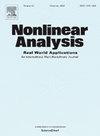Global attractor and robust exponential attractors for some classes of fourth-order nonlinear evolution equations
IF 1.8
3区 数学
Q1 MATHEMATICS, APPLIED
引用次数: 0
Abstract
We study the long-time behaviour of solutions to some classes of fourth-order nonlinear PDEs with non-monotone nonlinearities, which include the Landau–Lifshitz–Baryakhtar (LLBar) equation (with all relevant fields and spin torques) and the convective Cahn–Hilliard/Allen–Cahn (CH-AC) equation with a proliferation term, in dimensions . Firstly, we show the global well-posedness, as well as the existence of global and exponential attractors with finite fractal dimensions for these problems. In the case of the exchange-dominated LLBar equation and the CH-AC equation without convection, an estimate for the rate of convergence of the solution to the corresponding stationary state is given. Finally, we show the existence of a robust family of exponential attractors when . As a corollary, exponential attractor of the LLBar equation is shown to converge to that of the Landau–Lifshitz–Bloch equation in the limit of vanishing exchange damping, while exponential attractor of the convective CH-AC equation is shown to converge to that of the convective Allen–Cahn equation in the limit of vanishing diffusion coefficient.
一类四阶非线性演化方程的全局吸引子和鲁棒指数吸引子
本文研究了一类具有非单调非线性的四阶非线性偏微分方程解的长时间行为,包括d=1,2,3维的Landau-Lifshitz-Baryakhtar (LLBar)方程(含所有相关场和自旋力矩)和带扩散项的对流Cahn-Hilliard / allan - cahn (CH-AC)方程。首先,我们证明了这些问题的全局适定性,以及具有有限分形维数的全局吸引子和指数吸引子的存在性。对于交换主导的LLBar方程和无对流的CH-AC方程,给出了相应定态解的收敛速度的估计。最后,我们证明了当d≤2时,存在一个鲁棒的指数吸引子族。作为一个必然结果,LLBar方程的指数吸引子在交换阻尼消失的极限下收敛于Landau-Lifshitz-Bloch方程的指数吸引子,对流CH-AC方程的指数吸引子在扩散系数消失的极限下收敛于对流Allen-Cahn方程的指数吸引子。
本文章由计算机程序翻译,如有差异,请以英文原文为准。
求助全文
约1分钟内获得全文
求助全文
来源期刊
CiteScore
3.80
自引率
5.00%
发文量
176
审稿时长
59 days
期刊介绍:
Nonlinear Analysis: Real World Applications welcomes all research articles of the highest quality with special emphasis on applying techniques of nonlinear analysis to model and to treat nonlinear phenomena with which nature confronts us. Coverage of applications includes any branch of science and technology such as solid and fluid mechanics, material science, mathematical biology and chemistry, control theory, and inverse problems.
The aim of Nonlinear Analysis: Real World Applications is to publish articles which are predominantly devoted to employing methods and techniques from analysis, including partial differential equations, functional analysis, dynamical systems and evolution equations, calculus of variations, and bifurcations theory.

 求助内容:
求助内容: 应助结果提醒方式:
应助结果提醒方式:


